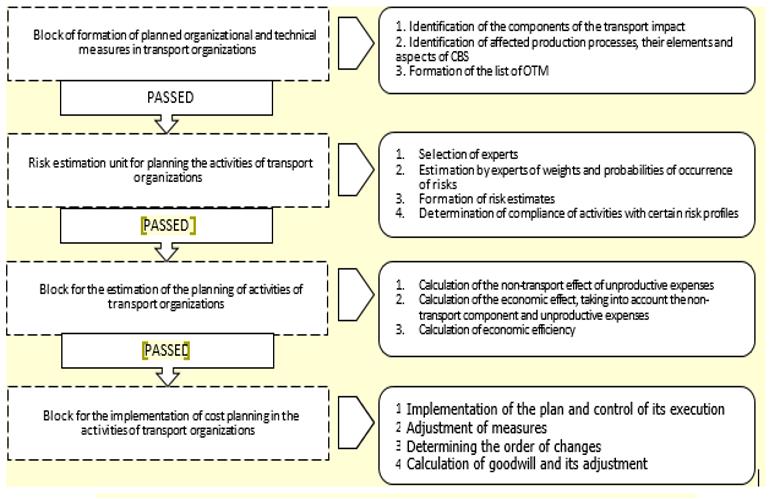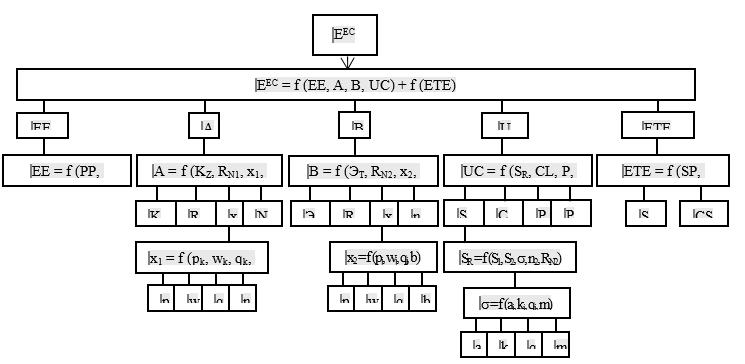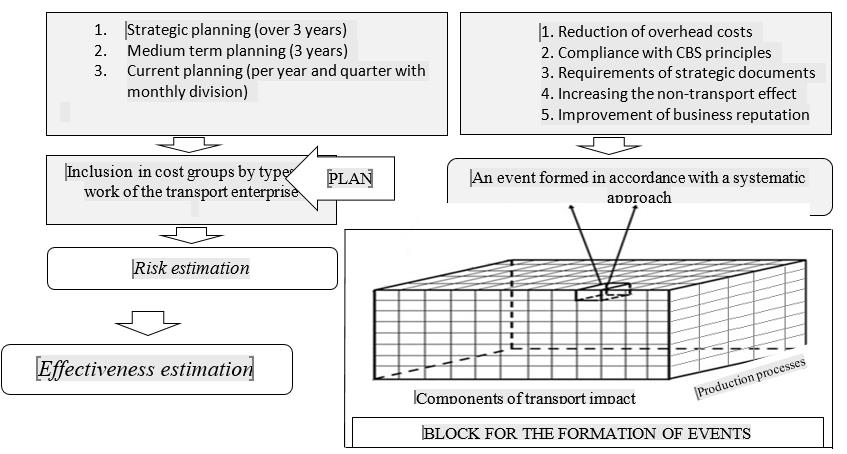Abstract
The authors of the paper considered a block diagram of planning organizational and technical measures, on the basis of which an indicator and a criterion for the estimation of the economic effect and efficiency are presented. All indicators and variables included in them are formalized. They are described and presented in the form of a system that clearly shows how one indicator can be formed from another. Each indicator is a function of many variables. All indicators for the estimation of the planned organizational and technical measures described in the paper are adjusted for uncertainty and risk calculated using the Delphi method. They are also brought to the initial planning period by applying the appropriate coefficients. According to the presented system of indicators, the authors, using a morphological model of quality and efficiency planning, show in what sequence the described indicators and criteria can be applied when planning organizational and technical measures of transport organizations to improve the quality and efficiency of their production activities in the aspect of corporate social responsibility. The results of the study can be applied both to develop an automated management system for enterprises in the transport industry and to conduct technical and economic calculations and develop plans for various levels in transport organizations.
Keywords: Assessment, indicator, model, planning, system
Introduction
Planning to improve the quality and efficiency of the production and economic activities of transport companies is associated with the development of new performance indicators. The most important principle on which these indicators should be based is the principle of consistency: all developed indicators should be interconnected with production processes and their elements. In this study, we are talking about the relationship between indicators for the estimation of quality and efficiency, building a system of indicators that can be used in the future to automate the work of enterprises in the transport industry. This determines the relevance of the chosen research topic.
Problem Statement
Each indicator presented in this paper includes a different number of variables, each of which is determined analytically. During the design of a system for automated management of resource planning, as well as for systemic management of planning at enterprises in the transport industry, it is necessary to understand what set of parameters is needed to calculate a particular indicator. Thus, there is a problem of information support for planning the quality and efficiency of the production and economic activities of transport companies. The solution of this problem is possible. In our opinion, it can be made by constructing a system of such indicators with the identification of all dependencies between them.
Research Questions
The provision of the efficiency of transport organizations is associated with the maximization of the effect obtained while minimizing costs. In general, the economic transport effect is the difference between the results of the organization's economic activities and the costs incurred to achieve them. In relation to transport organizations, various types of economic effects are determined: the economic effect of transportation, the economic effect of infrastructure modernization, the economic effect of the intermodality principle, etc. The increase in economic efficiency is a key factor in making economic decisions.
The effect and efficiency of the planned activities are derived from combinations of other variables: costs, income, realized risks, penalties, etc. Tracking these relationships is not always easy, because there are many variables and it is not always clear how exactly they should be taken into account in planning.
Purpose of the Study
The purpose of the paper is to develop a system of interrelated indicators for the evaluation of the quality and effectiveness of planned organizational and technical measures in transport organizations.
Research Methods
This study was performed using such scientific methods as the logical-analytical method, the method of system analysis, formalization, analysis and synthesis, methods of technical and economic calculations.
Findings
Cost planning in the improvement of the quality and efficiency of transport organizations should be consistent with the goals of enterprise planning at various levels. Moreover, it should include the phased application of the developed criteria. The transport organization is interested in the reduction of unproductive expensesand obtaining an economic effect from the implementation of the event, improving business reputation, as well as complying with the principles of corporate social responsibility (Kyriacou et al., 2019). These components must be taken into account when planning costs in the formation of organizational and technical measures (Barrientos et al., 2016). Thus, the block diagram of information support for planning to improve the quality and efficiency of transport organizations is shown in Figure 01.

For an integral assessment of the quality and economic efficiency of cost planning, the methodological recommendations suggest using the criterion of economic efficiency. It is determined according to the following formula (1).
(1)
The criterion of economic efficiency of the planned organizational and technical measures in transport organizations.
the size of the received economic effect, rub.
the amount of capital investments in the planned organizational and technical measure, rub.
the size of the total operating costs required for the planned organizational and technical measures, rub.
The indicator of economic effect is determined according to the following formula (2).
(2)
the level of the sectoral effect obtained before the implementation of the planned organizational and technical measures, rub.;
the level of the sectoral effect obtained after the implementation of the planned organizational and technical measures, rub.;
the level of non-transport effect obtained before the implementation of the planned organizational and technical measures, rub.;
the level of non-transport effect obtained after the implementation of the planned organizational and technical measures, rub.;
the risk-adjusted value of the volume of capital investments, reduced to the initial period, required after the implementation of the planned organizational and technical measures, rub.;
the risk-adjusted value of the volume of capital investments, reduced to the initial period, required before the implementation of the planned organizational and technical measures, rub.;
the risk-adjusted value of the volume of operating costs reduced to the initial period, which is necessary after the implementation of the planned organizational and technical measures, rub.;
the risk-adjusted value of the volume of operating costs reduced to the initial period, necessary before the implementation of the planned organizational and technical measures, rub.;
unproductive expenses incurred by the enterprise after the implementation of the planned organizational and technical measures, rub.
unproductive expenses incurred by the enterprise before the implementation of the planned organizational and technical measures, rub.
The systemic assessment is explained by the relationship between all indicators – each indicator can be represented as a function of many variables, where other indicators act as arguments. Information support of methodological recommendations for cost planning in the improvement of the quality and efficiency of the production and economic activities of transport organizations is shown in Figure 02.
The performance risk indicator of a planned organizational and technical measure is determined as follows: the expert method estimates the parameters of errors in the prediction of values for two indicators – the planned capital and operating costs for the implementation of an organizational and technical measure (Liu et al., 2011). The estimation is carried out according to a similar methodology, as in the case of the indicator of unproductive risk. Each expert must answer two questions: how much, in his opinion, can the real capital and operating costs deviate from the estimated ones? With what probability this will happen in both cases? (Galkina et al., 2021). It is proposed to calculate the indicator for the assessment of the economic risk of the increase in capital and operating costs using the following formula (3):
(3)
an indicator of economic risk associated with the increase in capital and operating costs for the implementation of the planned organizational and technical measures;
the probability of the increase in the capital costs of the planned organizational and technical measures, estimated by the kth expert;
the degree of increase in capital costs of the planned organizational and technical measures, estimated by the jth expert;
–a coefficient of qualification of the jth expert;
the number of experts.

It is necessary to consider initial capital and operating costs must (Macheret & Kudryavtseva, 2016). For this, a discount rate is used, which is equal to the projected values of annual inflation, adjusted for the annual decline in return on equity. In transport, there is a practice of the determination of the discount rate equal to the discount rate for any calendar year (Marchetti & Wanke, 2019; Vasilenko et al., 2021).
Adjusted indicators of capital and operating costs for the planned activity can be calculated using the following formulas (4) and (5):
(4)
(5)
– capital investments necessary for the implementation of any activity, invested at time z, rub.;
– operating costs necessary for the implementation of any event, invested at time t, rub.
n1 – the number of time periods during which capital investments are made in the event, years.
n2 – the number of time periods during which an activity is carried out and there are operating costs for it, years.
– the discount rate used to bring capital costs K back to the initial time period in time period n1.
the discount rate applied to bring the operating costs E to the initial period of time in the period of time n2.
The non-transport effect from the reduction of unproductive excess costs for the planned economic activities of the enterprises of the transport industry is determined by the following formula (6):
(6)
saved costs of social production in the implementation of economic decisions at transport enterprises, rub.
additional benefits of society from the improvement of the quality of transport enterprise, rub.
The indicator for the estimation of unproductive expenses without taking into account the quality of work includes three components: fines and legal costs incurred, as well as the necessary subsequent expenses of the transport company, operating or capital, necessary to restore the territory and eliminate the consequences of the traffic impact (Orzechowski et al,, 2018; Sokolov, 2015) . It can be represented in the following formula (7).
(7)
necessary subsequent costs (operational), which are aimed at to eliminate the consequences of the transport impact and restore the territory, rub.
unproductive excess costs arising from non-compliance with the principles of corporate social responsibility and excessive transport impact, rub.;
fines and legal costs of a transport company arising from non-compliance with the principles of corporate social responsibility and excessive transport impact, rub.
The formation of the the activities is carried out according to the constructed morphological model for the components of the transport impact (Drozdov et al., 2019). Figure 3 shows the morphological model of the formation and activities of the plan.

Thus, there is a phased application of the developed indicators and criteria for the estimation of the planned organizational and technical measures, as a result of which those activities that do not contribute to the reduction of unproductive expenses and are not focused on the increase in the out-of-transport effect, do not provide economic efficiency and must be replaced by others (Vasilenko et al., 2018). The developed economic solutions will be focused on the reduction of unproductive excess expenses and increase in corporate social responsibility.
Conclusion
Thus, the paper studied the issue of the formation of a system of indicators necessary for information support for planning to improve the quality and efficiency of the production and economic activities of transport organizations. In accordance with the block diagram of planning, on the basis of the presented indicator and the criterion for the estimation of economic effect and effectiveness of the planned activities, a system of indicators is created that allows visualizing the relationship between various parameters and variables necessary for the evaluation of activities.
The use of the presented system is carried out in accordance with the morphological model, which allows isolating only those organizational and technical measures that are aimed to increase not only the industry, but also the extra-transport effect, as well as reduce the unproductive costs of transport companies.
References
Barrientos, F., Moral, A., Rodríguez, J., Martínez, C., Campo, F., Carnerero, R., & Sainz, G. (2016). Knowledge-based minimization of railway infrastructures environmental impact. Transportation Research Procedia, 14, 840–849.
Drozdov, N. A., Kuzina, E. L., Vasilenko, M. A., Tagiltseva, J. A., Sheremetieva N. A., & Semibratova S. V. (2019). Algorithm for Assessing the Extra-Sectoral Effect of Improving Organization Quality. International Scientific Conference Social and Cultural Transformations in the Context of Modern Globalism (SCTCMG 2019), Vol. 1 (pp. 789–797).
Galkina, E., Pochekaeva, O., & Zheleznova, N. (2021). Optimization of the costs of a transport company in the implementation of multimodal transport. Russian Journal of Water Transport, 123–132.
Kyriacou, A. P., Muinelo-Gallo, L., & Roca-Sagalés, O. (2019). The efficiency of transport infrastructure investment and the role of government quality: An empirical analysis. Transport Policy, 74, 93–102.
Liu, G. Y., Yang, Z. F., Chen, B., & Zhang, Y. (2011). Ecological network determination of sectoral linkages, utility relations and structural characteristics on urban ecological economic system. Ecolog. Modell., 222, 2825–2834.
Macheret, D. A., & Kudryavtseva, A. V. (2016). On assessment of investments efficiency in innovation projects. Railway economy, 12, 21–26.
Marchetti, D., & Wanke, P. F. (2019). Efficiency in rail transport: Evaluation of the main drivers through meta-analysis with resampling. Transportation Research, part A: Policy and Practice, 120, 83–100.
Orzechowski, M., Mrozik, M., & Danilecki, K. (2018). Investments of transport companies. AUTOBUSY – Technika Eksploatacja Systemy Transportowe. 19, 216–218.
Sokolov, Y. I., & Lavrov, I. M. (2015). Transport service quality enhance. Railway economy, 8, 76–81.
Vasilenko, M., Kuzina, E, Galkin, V., & Drozdov, N. (2021). Managing the Development of the Environmental Protection System in Transport Companies. IOP Conference Series: Earth and Environmental Science. 666, 062079.
Vasilenko, M. A., Drozdov, N. A., Kuzina, E. L., & Tagiltseva, Y. A. (2018). Directions of Transport Development in Advanced Marketing. 2018 IEEE – International Conference Quality Management, Transport and Information Security, Information Technologies (IT&QM&IS), Vol. 1 (pp. 172–176).
Copyright information

This work is licensed under a Creative Commons Attribution-NonCommercial-NoDerivatives 4.0 International License.
About this article
Publication Date
25 November 2022
Article Doi
eBook ISBN
978-1-80296-127-0
Publisher
European Publisher
Volume
128
Print ISBN (optional)
-
Edition Number
1st Edition
Pages
1-742
Subjects
Sociolinguistics, linguistics, semantics, discourse analysis, translation, interpretation
Cite this article as:
Drozdov, N. A., Kuzina, E. L., Vasilenko, M. A., Tagiltseva, J. A., Skichko, E. M., & Mushegyan, A. O. (2022). Planning And Estimation Of Organizational And Technical Measures In Transport Companies. In D. Bataev, S. A. Gapurov, A. D. Osmaev, V. K. Akaev, L. M. Idigova, M. R. Ovhadov, A. R. Salgiriev, & M. M. Betilmerzaeva (Eds.), Social and Cultural Transformations in the Context of Modern Globalism (SCTCMG 2022), vol 128. European Proceedings of Social and Behavioural Sciences (pp. 203-210). European Publisher. https://doi.org/10.15405/epsbs.2022.11.28

